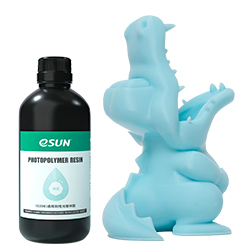How to choose 3D printing materials?
Choosing between filament and resin for 3D printing materials depends on various factors, including the specific requirements of your project. Here are some considerations to help you decide between the two:
3D Printer Filament:
Strength and Durability: Filaments like ABS, PETG, or nylon generally offer higher strength and durability compared to most resin-based 3d printing materials. If your project requires robust mechanical properties or impact resistance, filament-based printing might be preferable.
Cost: Filaments are generally more cost-effective compared to 3d printer resin. Filament-based printers are often more affordable, and 3d printer filaments themselves tend to have a lower price per unit of volume. If budget is a significant concern, filament-based printing may be the more economical option.
Ease of Use: Filament-based 3D printers are generally easier to set up and operate, making them more beginner-friendly. Filament printing typically requires fewer technical adjustments and considerations, such as resin handling and post-processing requirements.

Availability and Variety: 3D printing filaments are widely available in a range of materials, colors, and finishes. You can find filament options suitable for various applications, including flexible filaments, composite 3d printer filaments, and specialty 3d printing materials. The extensive variety of 3d printing filaments allows for greater flexibility in material selection.
Size and Scale: If you plan to print larger objects or require a larger print volume, filament-based printers are generally better suited for such projects. Resin printers typically have a smaller build volume and may not be suitable for large-scale prints.
3D Printer Resin:
High Detail and Precision: Resin-based printing, such as Stereolithography (SLA) or Digital Light Processing (DLP), offers exceptional detail and precision. If your project involves intricate designs, small parts, or high-resolution models, resin printing is often the preferred choice.
Smooth Surface Finish: Resin prints typically result in smoother surface finishes compared to filament-based prints. If your project requires a high-quality surface finish, such as for artistic or display purposes, 3d printer resin printing can provide superior results.
Material Properties: Resin 3d printing materials can offer unique properties not commonly found in 3d printer filaments. For example, there are resin options with exceptional transparency, high temperature resistance, or flexible characteristics. If your project demands specific material properties that are best achieved with resin, it may be the preferred option.

Post-Processing: Resin prints generally require post-processing steps, such as rinsing in a solvent, curing under UV light, and additional support removal. These additional steps can add complexity and time to the printing process.
Safety Considerations: Resin printing involves the use of liquid resins that may emit strong odors or potentially hazardous fumes. Adequate ventilation and appropriate safety measures should be taken when working with resin-based printers.
Ultimately, the choice between 3d printer filament and 3d printer resin depends on your project requirements, budget, desired level of detail, and available equipment. Consider these factors carefully to determine which 3d printing materials best align with your specific needs.
Comments
Post a Comment